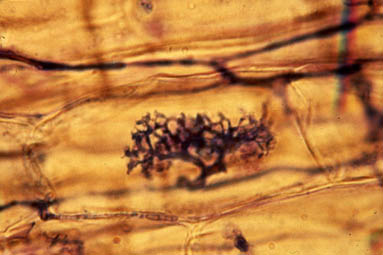More than 80% of higher plants can be colonized by mycorrhizal fungi. The hyphae of these fungi more extensively penetrate the soil and can better exploit minerals and water from the soil particles than the plants roots can. Plants are non-colonized by fungi when nutrition is optimal. However, under all kind of stress (water or nutrient-deficiency, stress caused by heavy metals or salts, low soil pH, attack by phytopathogenic organisms etc.) the roots of the plants are colonized. Mycorrhiza is apparently the most important symbiosis in nature. Mycorrhiza is subdivided into ectomycorrhiza (internal hyphae do not penetrate the cell-wall of roots) and endomycorrhiza (cell wall of the roots is penetrated). The main form of endomycorrhiza is the arbuscular mycorrhiza where fungi of the order Glomales are the symbiotic partners.

An arbuscule of arbuscular mycorrhizal fungi
Where phosphorus is limiting, phosphates of low solubility are made available to the plants which then often show increased growth, blooming, and tolerance against pathogens.
|
